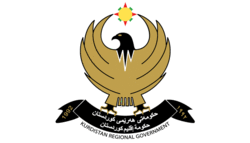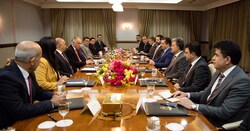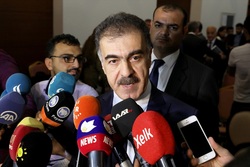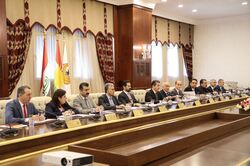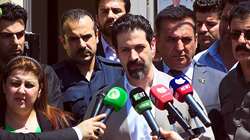Will US support for stability in Kurdistan regions continue?, Report
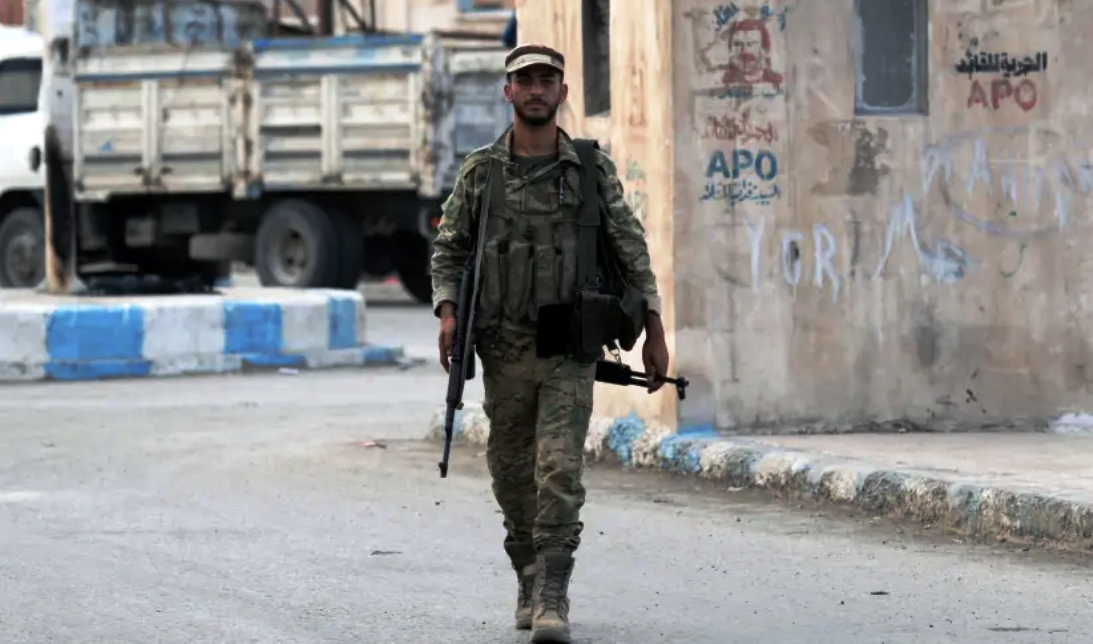
Shafaq news/ Questions are being raised about the US's long-term role in eastern Syria and what it will do about Iranian-backed attacks on its forces in the Kurdistan region of Iraq.
The role of the United States in helping to create stability and relative prosperity in the Kurdish regions of Syria and Iraq has been key to the role those regions play today. However, all of that success hinges on a delicate balance.
In both cases, US policy has been threatened by Turkish and Iranian attempts to undermine that stability and questions are now being asked about the US’s long-term role in eastern Syria, and what the US will do about Iranian-backed attacks on its own forces in the Kurdistan region of Iraq.
The two Kurdish regions of Syria and Iraq are very different.
The Kurdistan region of Iraq is formally and legally an autonomous zone in Iraq with its own government that sits in the capital, Erbil. It has elections and has complex politics, much of them rooted in two powerful clans, the Barzanis and the Talabanis.
The Kurdistan Regional Government of Iraq (KRG) has its own armed forces – the Peshmerga – and these units are split into divisions, with some close to the Barzani-led Kurdistan Democratic Party and others linked to the Patriotic Union of Kurdistan Party, led by the Talabanis and their supporters.
On the ground, the area has been an economic success story and many Iraqis have fled there from other parts of their country which lie in chaos. Yazidis, Christians, Turkmen and others make up the diverse fabric of the KRG’s society. Many Arabs fled ISIS to the KRG and when ISIS was gone, others fled from the pro-Iranian Shi’ite “militias” for safety in Erbil.
The area is also heavily influenced by the Turkish economy through banks and products, because it exports and imports to neighboring Turkey. It also has connections to Iran.
Turkey has bases in the KRG where the country claims to be fighting the PKK (Kurdistan Workers' Party), but it is actually expanding its influence. Rumors say Turkey wants to move further inland, to Sinjar, or closer to Dohuk and Erbil.
Meanwhile, Iran also wants to play a role as it aims to crush Iranian dissidents in the KRG. Specifically, it wants the PDKI (Democratic Party of Iranian Kurds), PAK (Kurdistan Freedom Party) and other suppressed parties.
The US has helped this region. It has trained Peshmerga through anti-ISIS Coalition-supported organizations such the Kurdistan Training Coordination Center (KTCC) and has a sprawling base at Erbil international airport. That base has now come under attack from pro-Iranian “militias”, including a sophisticated drone strike in April.
This means that US support is key to security and stability. The Kurdistan region is the one place in Iraq that US soldiers are generally welcomed and liked by locals. Threats may come from outside, but not within.
However, the region is being hammered like an anvil through Iranian and Turkish pressure. Both countries want the US to leave so that they can partition states such as Iraq and Syria with Kurdistan situated in the middle of it all.
For a time, during the war against ISIS, the Kurdish region was a strategic and successful hinge, playing an outsized role. The KRG ran Kirkuk and Sinjar and the Iraqi state was so weak, that the KRG functioned far more like a state than Baghdad did, but the situation has changed over time.
The Kurds have seen this before and have been abandoned in the past. They have been sacrificed due to US machinations during the Cold War, and past hopes on relying on Russia, the US or others have been dashed.
The KRG knows this; its leaders like President Nechirvan Barzani, Prime Minister Masrour Barzani, and Lahur Talabani grew up with lessons they were taught by Masoud Barzani and Jalal Talabani. US support for the KRG is vital but it is not the only game in town. The region is successful and has many friends, from France to Hungary to Canada.
It knows how to navigate the Turkish demands and Iran. It is also generally admired in some Iranian and Turkish circles.
Iran’s regime brags that it saved the Kurdistan region from ISIS and there is even a video in which Masoud Barzani, during the dark days of August 2014 when all seemed lost, was greeted by Qasem Soleimani, who arrived in Erbil with Iranian support.
This is partially true. When Erbil needed help, Iran was there, because unlike the genocidal Saddam regime of the past, Iran has never committed genocide against the Kurds. Unlike Turkey, which denied the Kurds existed, Iran has always had a Kurdish province. Unlike Syria, where Kurds couldn’t even get citizenship, at least in Iran they were citizens.
The Kurdish region of Iraq, called Basur, or southern Kurdistan, is only one of the important and successful Kurdish areas. Rojava, western Kurdistan, is the Kurdish region of Syria. Rojava, a relatively small region and less populous than the Kurdish regions of Turkey, Iran and Iraq, was largely ignored and abandoned by the Assad regime.
Only when the Syrian revolution began did the regime begin to understand that it needed the Kurdish region and tried to ameliorate past oppression. This didn’t work well, but it did mean that when the Kurdish People’s Protection Units (YPG) emerged, the regime could fade away, while leaving some soldiers behind in places like Qamishli. The regime intended to return as it faded away during the Syrian civil war.
A beneficiary of the civil war was the YPG and its constituent civilian authorities, the PYD (Democratic Union Party) and other groups linked to it. By 2014, when ISIS was rampaging and committing genocide in Iraq, the YPG helped the Yazidis flee via Syria to internally displaced persons camps. This prevented a worse genocide.
The US authorities and the nascent coalition forming saw this success and America began to support the YPG, which helped form an anti-ISIS umbrella army called the Syrian Democratic Forces (SDF). It was here that Brett McGurk, then the anti-ISIS czar, and others played a key role. US special forces came in to fight and soon the SDF was pushing ISIS back, eventually destroying it altogether in Raqqa in 2017 and squeezing it to death in Baghuz on the banks of the Euphrates in 2019.
SDF success, however, had a boomerang effect in Turkey across the border. Turkey, run by an extremist far-right Islamist government in the AK Party, wanted to crush Kurdish aspirations and launched a war against the PKK in 2015.
They accused the PKK of being the same as the YPG and this led Turkey to invade Syria in 2016, and in 2018 they ethnically cleansed Afrin of Kurds. Turkey’s narrative was that Kurds in eastern Syria – Rojava – were seeking to link up with Kurds in Afrin near the coast.
US authorities were concerned, but under the Trump administration, a pro-Ankara lobby came into power throughout parts of the US government. The lobby, staffed by former diplomats who had served in Turkey and adored Erdogan, wanted the US to pivot from supporting the SDF and Kurds to supporting jihadists in Idlib called Hayat Tahrir al-Sham (HTS) and various Turkish-backed extremist groups called the Syrian National Army.
These groups openly murdered Yazidis and vowed to “kill the kuffar” or “infidels” and posted photos of themselves machine-gunning women. They were similar to ISIS, but for some US officials, these were the groups that could march on Damascus and through them, the US would get back into Turkey’s good graces.
Like the US Cold War mentality that had once abandoned Kurds in the 1970s and adored Saddam Hussein’s regime of poison gas attacks on civilians, some US officials liked the far-right jihadists and found them exotic and an “asset” in the region. Meanwhile, other US officials, who preferred the peace and stability that the SDF had brought, rather than chaos and genocide of groups like HTS, told the Kurds that the US would stick with them if they made some concessions here and there.
Concessions would mean letting Turkey occupy Afrin and expel its entire Kurdish population, some 170,000 people, and then occupy Tel Abyad and expel the Kurds there as well.
Turkey said at the UN in 2019 that it would take over a “buffer zone” along the border of Syria and expel the Kurds and replace them with Arabs from Syria. This was to be total ethnic cleansing; similar to 1940s Poland when Nazi-Germany occupied it. The UN applauded Turkey’s plans. The only thing standing in the way were a few US special forces.
In the end, Turkey was frustrated in its aim to destroy Kobani, Qamishli, Derik and other Kurdish towns, by a Russian and Syrian regime strategy that let a few rag-tag regime soldiers rush into the Kurdish areas and put up the regime flag.
Turkey acquiesced to smaller ethnic cleansing around Tel Abyad. They had one last mission though: kill the young Kurdish woman known as Hevrin Khalaf who was a Kurdish politician and a promising rising star in eastern Syria. Likely acting with direct intelligence from Ankara, Turkish-backed Syrian extremists hunted her down in October 2019 and murdered her. A Turkish newspaper applauded the operation. Some in the Trump administration were dismayed. Others toasted a successful operation that might break US support for the SDF.
Enter US President Joe Biden. Removing the pro-Ankara lobby upon coming into office, Biden has tried to keep stability in eastern Syria, but there are some concerns.
An oil company given a concession under Trump, appears to be losing its concession. Reports say funding will be cut for the SDF. The US has trained some 80,000 SDF members to fight ISIS.
There are tens of thousands of internally displaced people in al-Hol camp and thousands of ISIS detainees in eastern Syria. Many of them are foreigners, including from Europe, but Europe won’t take its ISIS members back. This creates an economic as well as security burden.
The question is whether the US can maintain the stability it has helped create in eastern Syria, because the area has been an anchor of stability. What happens in Rojava also matters for the KRG across the border. This is despite the fact that the authorities in the KRG don’t get along with the Kurdish-led authorities in eastern Syria. That is politics and has its own reasons, but is also due to Turkish pressure.
Turkey wants the Kurdish regions divided and compliant. It wants the US out. The question is whether the US will remain and do more than in the past.
Source: The Jerusalem Post.

